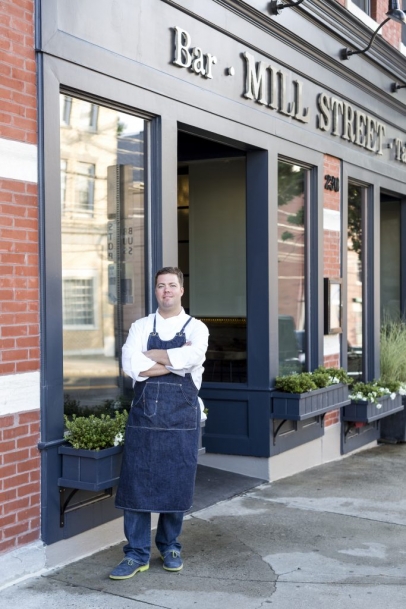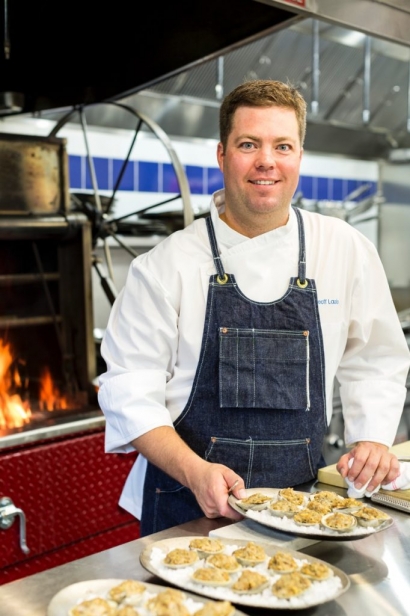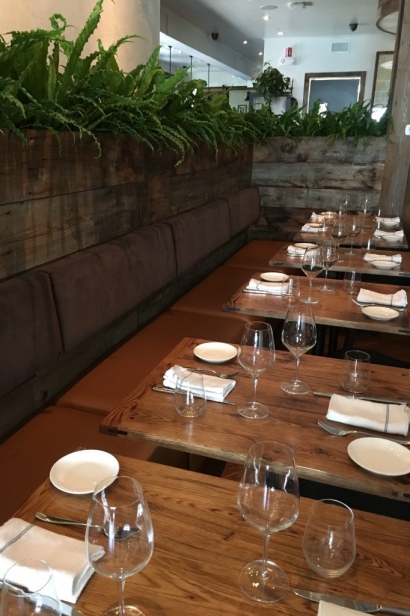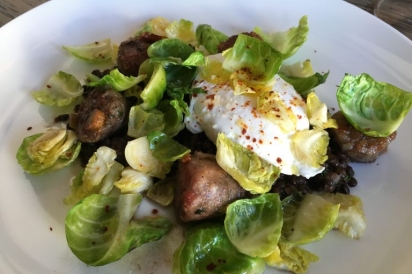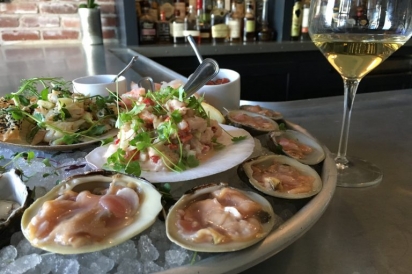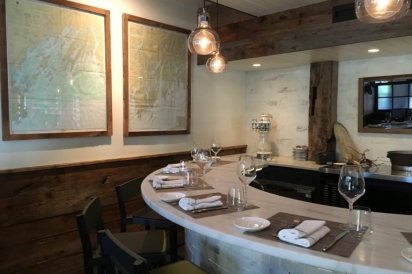Geoff Lazlo and Mill Street Bar & Table
Geoff Lazlo loves food.
“I love Asian food. In particular, I love Japanese food. And I like French food. And I like Italian food. And I really like Middle Eastern food and Latin American food.”
As Executive Chef and Managing Partner for Mill Street Bar & Table in Greenwich, Geoff’s love for food is well placed, and his personal interest in food informs every part of what Mill Street has to offer.
“The menu is very selfish of me. It’s basically all my favorite foods. The menu here has a great deal of diversity, and I think it’s because I like everything. For me, Mill Street is about celebrating all that’s beautiful in food.”
At Mill Street, that beauty is not confined to the food. Located in the Byram hamlet of Greenwich, Mill Street occupies an 1855 building that is divided into numerous rooms and nooks – a byproduct of the many phases of construction the site has seen over its long lifetime – and each has its own flavor that creates the “sophisticated tavern” feel that dominates the space. From the marble-topped raw seafood bar, to the sunny, backyard patio, to the quiet, windowed enclave for smaller groups, Mill Street’s cozy-yet-elegant feel sets the stage for the classically American (and yet incredibly new and innovative) food that is served here. And that food – and Chef Lazlo’s relationship to it – is what truly makes Mill Street a wonderful dining experience.
FROM GROWING FOOD TO PREPARING IT
Geoff Lazlo is a Connecticut native who grew up in a farming family.
“My great-grandparents came from Poland in 1900. They lived in New Britain and had three plots on which they grew everything from fruit trees with several different grafts on them, to potatoes, to corn. They grew every single vegetable, they foraged for mushrooms, and they hunted. They made dandelion wine. They were almost totally self-sufficient.”
This heritage of farming and gardening has been passed down through the generations in his family, which started with Lazlo when he was a boy.
“I had my first garden when I was five, which I planted with my dad. Ever since, I’ve always planted a garden; it’s something that I just enjoy doing. It wasn’t about having it for cooking, necessarily, although that’s what we did with it. There’s something that I just enjoyed about working outside and growing a plant, specifically vegetables. When it comes to what I do in the kitchen, the idea of growing has always been central. That’s really how my personal tie to food begins.”
Chef Lazlo’s knowledge of and experience with vegetables translates directly into his dishes, including Mill Street’s Raw Beet Salad. Composed of thinly shaved beets, sliced green apples, watercress, toasted almonds, and coriander seeds, the dish shows off both the taste and textural variety of New England’s fruit and vegetable selection. But the heart of the salad – and of all Lazlo’s dishes – is in his choice of ingredients.
“Take, for instance, the watercress in this salad,” Lazlo explains, “which I get in spring from Stietzel Farm up in Redding. Watercress grows, basically, in water, and you have to have a clean source of it. Usually it requires a natural spring because the plant needs so many nutrients. Since different springs carry different minerals and nutrients in their water, each farm will grow distinctly different flavors of watercress. It’s really a terroir-based thing.”
One of the unique advantages Chef Lazlo enjoys at Mill Street is the restaurant’s connection to farming. Mill Street is one part of the Back 40 Farm Group, which incorporates Back 40 Mercantile in Old Greenwich, Back 40 Kitchen in Greenwich, and Back 40 Farm in Washington, Connecticut. For Mill Street, having an “in-house” farm from which to draw organic produce provides a connection between the kitchen and the land, as well as a reason to engage in culinary experimentation.
“I speak to Alexis Barbalinardo and Enya Cunningham [the Back 40 Farm managers and farmers] all the time,” Lazlo says, “We meet in the winter, and we sit down, and we talk about crop rotations and different varieties of crops, including what I’d like to use in the kitchen. We have a very candid dialogue of what grows well at the farm and what doesn’t make sense, in terms of the capacity of what Back 40 Farm has the room and means to grow. As the crops begin to come in, they deliver fresh produce to us once or twice a week.
“And we go to them, as well. My goal is to bring the restaurant staff up to the farm every six months. They get to meet the chickens. They get to meet the farmers. And they get to walk around and see the farm, which connects the staff to what we’re doing in the kitchen. You might be surprised by how many people who work in kitchens have never been to a farm or seen food growing, before it reaches the kitchen.”
Sometimes, working with a small farm presents novel challenges that keep Chef Lazlo thinking outside the box. At the end of last season, Back 40 Farm had 60 egg-laying hens that were due to be retired. (That’s a nice way of saying, “be made into dinner.”) However, when it comes to chickens, older hens are considered less desirable because they tend to have tougher meat than young birds. Rather than turn down these chickens that might not have easily found another buyer, Lazlo took 40 of them and set to work, using nearly every part of the bird.
“We poached them very gently and chopped up the meat. Then we took the bones and roasted them, and then made a stock. We took the livers and made chicken liver mousse. We confited the gizzards and the hearts. All of this went into a chicken pot pie, which turned out to be one of our best-selling dishes. We even took the skin and dried it out, which we served as a crispy garnish atop sautéed gizzards and heart, served on toast. We made two complete dishes and threw out virtually no part of any of those 40 birds.”
Although Chef Lazlo has an abiding affection for Italian food, he makes no claims to a true Italian cooking heritage.
“I would never say that I’m an Italian chef and that I can cook straight Italian dishes. And I wouldn’t dare to, because I feel like people who have studied those cuisines and have grown up in those cultures…they really know their cuisine inside and out. And I’m always excited to learn about that, but what I try not to do is take a dish and replicate it. Instead, I take what I like about that dish – whether it’s a type of ingredient, like a spice, or a lentil, or texture – and then try to translate it into something that’s original and that falls within the genre of American cooking.”
Which is exactly what he does with his slightly deceptively named Roasted Brussels Sprouts dish. Intended as a hearty, winter plate, it proved popular enough to merit more time on the regular menu. Despite the name, the heart of the dish is really Cotechino sausage, a charcuterie that is considered a traditional Italian food. Mixed with warm, winter spices, the skin from the pork is chopped up and ground back into the sausage, along with ground pistachio, and typically served around the holiday season in Italy.
recounts a recent visit to Fleishers Craft Butchery – the source for much of Mill Street’s meat – when he saw a batch of Cotechino on display. “This is my favorite sausage,” he recalls thinking, and immediately took some back to Mill Street to experiment with in dishes.
“We made this dish, and I loved it, so I called them up and asked for another five pounds, and they told me ‘Well, we only made it for that one week, which was New Year’s, so now we’re out.’ So I asked them if they’d make a special batch for me, and they said, ‘Sure, but we can only do it if we do a 40-pound batch.’ I agreed, and I think they were surprised and assumed there was no way I could sell all of it. I called them back 10 days later to let them know I already needed more. It became one of our most popular dishes.”
That popular dish includes the roasted Cotechino on a bed of lentils, covered with roasted Brussels sprouts and drizzled with a deglazed vinegar that lends an acidic balance to the richness of the pork. It is topped with a poached egg that, when broken, gets soaked up by the lentils to create a sauce. Of course, Lazlo admits, there’s a bit of showmanship in everything, and in this case he appealed to the vegetable nature of the plate. “Part of the reason this dish sells so well is how I’ve named it. It’s called Roasted Brussels Sprouts.”
MILLSTREET’S RAW BAR
Chef Lazlo’s interest in locally farmed products is not strictly terrestrial. Mill Street’s elegant, marble-topped raw bar boasts an impressive selection of locally sourced seafood and shellfish, much of it from the Long Island Sound, and that shellfish’s history is interwoven with the Sound’s.
“When I was a kid, I loved to sail and race boats,” Lazlo says, “but we would get called off the water all the time. There’d be some kind of a leak or other pollution problem, and it really wasn’t safe to swim in. It seemed to be getting worse, but then, all of a sudden, it got much healthier.”
Around 20 years ago, Lazlo met Jardar Nygaard, an oyster fisherman who took inexpensive leases on plots of land right off Greenwich and Stamford with the intent of harvesting oysters. Lazlo recalls that Nygaard was dismissed by the locals as crazy, due to the deleterious water condition of the Sound.
But, Lazlo recalls, “he had foresight and knew that this waterway could sustain great oysters and grow them, so he took the chance and developed them. The water’s clean now, and oysters help to clean the water.”
Lazlo’s interest in his oysters goes deeper than them simply being local.
“Obviously, he is right here and I’ve known him for a long time, so there’s a connection. But he really is intensely focused on creating the best oysters. He has them in a cage, but he doesn’t put them on the bottom. If they’re on the floor of the Sound the oysters come out darker, because all the sediment gets into the shell. And Nygaard says they almost suffocate there, because the bottom has so much mud. But if you come up a bit off the bottom, they end up in this water column, which essentially is a stream or a river that’s underneath the sound and that’s constantly flowing with the tides. It’s carrying with it fresh oxygen and nutrients, so the oysters stay clean, they look better, and they taste better, because they’re constantly being fed. It’s a great system.”
In addition to fresh, local harvests of oysters and clams, Mill Street’s raw platter can include a lobster salad (“We make a lobster stock and reduce it, and add that to a mayonnaise, so it’s an enriched lobster flavor.”), a crab salad (“It includes a little bit of lime juice, and then we add some kohlrabi for crunch and some mint for freshness.”), plus some non-raw, New England favorites like fried clams, fried oysters, and even baked clams and grilled oysters.
“We get live sea urchin and blood clams from Cape Cod, and razor clams from Maine. Anything that is shellfish related that I can get my hands on will make an appearance on that raw bar menu.” Truly, the declaration of a man who loves food.
THE MISSION
Despite his many influences, Chef Lazlo is secure in the culinary identity he has forged at Mill Street, as well as with the ethical foundation on which his cooking rests.
“I find that the style of cooking that we do at Mill Street is American. I want to cook food that is seasonal to the northeast, and more specifically, to Connecticut. I think one thing that drew me and my family back here is that I’m from Connecticut. My son’s fourth generation, now. I’d say that my relationship to Mill Street is more personal than any other restaurant with which I’ve worked, and I get really excited about it.
“The mission is to represent best, in our own unique way, what a local, sustainable food system looks like in the northeast. The most important aspects of that are creating delicious food that we feel good about serving to our guests, and supporting local farmers in such a way that restaurant patrons and farmers, alike, can understand and be a part of.
“We don’t want to push our ideas down anyone’s throat. I don’t want to be didactic. I’m very quiet about it in the sense that our menu doesn’t list all the farms that we source our products from. Our menu doesn’t list that our food is organic, but Back 40 Farm grows exclusively organic produce for us to use.
“I feel like it’s better to ‘walk the walk’ than ‘talk the talk.’ That’s why I’m involved with the Garden Education Center, growing sprouts there. We’re involved with Abilis, who grow microgreens for us in town. We have 12 plots in the Greenwich Community Gardens. The St. Paul Lutheran church gave us 1,600 square feet. In Greenwich, alone, we’re growing 3,000 square feet of our own garden that helps supply our kitchen, every week.
“I just want to do what I believe in. And, hopefully, everyone will agree and then they’ll jump onboard too. I think that that’s part of the organic nature of this, is that you can’t change people. You just have to have people see what you’re doing and then have their own ‘aha!’ moment and say, ‘Hey, why is that working so well for them?’ That’s how movements like this transition into traditions.”
> Mill Street Bar & Table: 230 Mill Street, Greenwich; 203-813-3323; millstreetct.com


